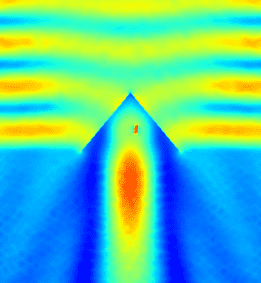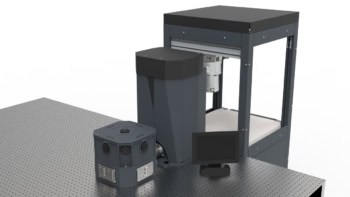
A theoretical study has modelled how radio waves behave when passing through the Great Pyramid of Giza in Egypt. Mikhail Balezin and colleagues at St Petersburg’s ITMO University in Russia and Germany’s Laser Zentrum Hannover used multipole analysis to approximate how the electromagnetic waves would be influenced by the famous landmark. As well as offering a new way to study interiors of huge structures, the technique is also being used to characterize pyramidal nanoparticles.
The interior of the Great Pyramid has been probed using various forms of radiation including cosmic muons. Indeed, the muon study has found evidence for a previously unknown chamber buried deep within the iconic structure.
Now, Balezin and colleagues have performed the first study of how the pyramid would interact with radio waves. They constructed a numerical model to simulate the behaviour of radio waves with wavelengths of 200-600 m as they passed through a virtual pyramid. Such wavelengths were chosen because they are slightly longer than the physical dimensions of the Great Pyramid, which is about 140 m tall and measures 230 m along each of its four sides.
Solid limestone
The team first modelled the pyramid as solid limestone with no internal chambers. Then, they looked at how the presence of chambers would affect the radio waves. Their simulations predict that the chambers act as resonators, concentrating electromagnetic energy inside the chambers. They also found that the pyramid as a whole focussed radio waves incident from above into a region just below the structure.
The team worked-out that some incident waves would be scattered by internal structures and that others would be absorbed. They were also able to map the distribution of electromagnetic fields inside the pyramid.
The simulations used multipole analysis – a mathematical technique that can approximate interactions between complex objects and electromagnetic fields. The technique involves replacing the object with much simple set of radiation emitters known as multipoles. With a knowledge of the properties of each individual multipole, the researchers could use mathematical functions to approximate how their combined emitted field would be scattered.
Similar scales
Normally, the team studies interactions between light and nanoparticles – where the wavelength of the light is also larger than the size of the structures of interest. This similarity inspired Balezin and colleagues to look at pyramids and show that on very different length scales of nanometres and hundreds of metres the scattering of electromagnetic waves ultimately depends on the size, shape and refractive index of the objects.

Muons reveal hidden void in Egyptian pyramid
The team is now looking at how pyramidal nanoparticles can be used in new and innovative ways to create new technologies such as nanosensors and highly efficient solar cells. The team also plans to do further simulations of the Great Pyramid using radio waves at shorter wavelengths.
The research is described in the Journal of Applied Physics.



